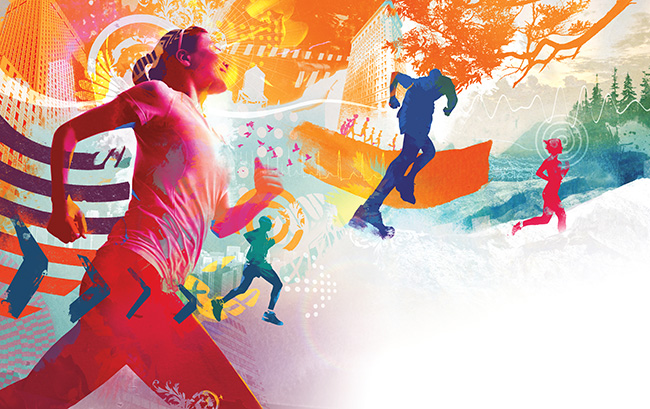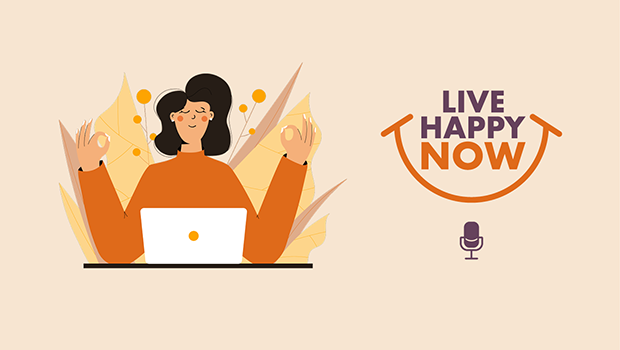Researchers and avid runners swear it’ll make you healthier and happier.
Dusty Olson was barely halfway through the 50-kilometer Speedgoat endurance run in Utah’s Wasatch Mountains when the cramps started. The sharp pain originated in his thighs, but then spread throughout his legs, nearly crippling him. The cramps were so severe, he was forced to stop running and lie down on the dirt trail, sweating and shuddering.
He waited a few minutes, then peeled himself off the ground and started running again. Miles down the trail, the cramps returned and he was back in the dirt. He continued this pattern until he crossed the finish line, more than six hours from the time he’d started.
“There’s no way I wasn’t going to finish,” Dusty says. “Even with the cramps. Anytime I’m out there, moving and getting that release, even with pain, it feels good.”
Dusty Olson is a long-distance fiend. He grew up in Duluth, Minnesota, a nationally ranked Nordic skier who ran cross-country in high school as training for his winter sport. He won junior nationals in Nordic skiing and took top honors at a regional cross-country championship. Built long and lean with a mop of wavy blond hair, his body got accustomed to four-hour-long runs, the miles vanishing beneath his feet.
At age 19, in 1993, he signed up for his first endurance run, the Minnesota Voyageur 50-miler. He won the race, pulling into the lead halfway through and surprising even himself. Soon after, he started training for long runs with his friend, Scott Jurek, with whom he’d grown up skiing. When Scott entered his first 100-mile race, Dusty offered to pace him, meaning he’d run alongside him for the latter half of the race, setting the tempo, shining an extra flashlight on the trail when darkness settled in, and making sure Scott got enough food and water.
Scott went on to become one of the country’s top ultra-marathoners, with a record seven consecutive wins at California’s 100-mile Western States run. In 2010, Scott set a record by running 165.7 miles—the length of six and a half marathons—in a 24-hour period. Throughout it all, Dusty was his sidekick, his trusted partner on the trail who kept him on track when things got tough.
By late 2010, it was Dusty who started suffering. His knees and legs felt heavy and he was experiencing flu-like symptoms, a fever and cold sweats. He visited a handful of doctors and eventually got a diagnosis: He had Lyme disease, contracted from a tick bite months earlier. Doctors told him he should take time off from running and let his body and immune system recover.
But after 20 years of running long distances, Dusty couldn’t imagine life without running. He runs year-round, even in the cold Minnesota winters. Logging those miles make him who he is. It’s what fills him with joy and gives him a sense of release.
“Once you get efficient at running, you get that feeling of Zen, or runner’s high,” says Dusty. “You gain that outer-body sensation where you’re just floating through the trail or up the hill.”
Without that sensation, how was he supposed to face the rest of the world? “It was hard to deal,” he says. “When you can’t run, you don’t have that path to escape, that channel to sort things out in your daily life.”
Dusty had discovered something scientists are still trying to figure out. Somehow, the act of putting one foot in front of the other gave him an unrivaled sense of bliss. We call it runner’s high, the chemical reaction in your body triggered by vigorous exercise that helps improve moods and reduce stress. Researchers are still studying how it works, but one thing appears clear: Running can send you on the path to happiness.
Your Brain on Running
The act of running isn’t necessarily pleasurable. Sore legs, pounding heart, constricted lungs. But there’s something about running that has a nearly supernatural ability to turn physical discomfort into a feel-good, emotional sensation.
Even people who say they hate exercise generally agree that they feel better—and happier—after a workout. It’s called runner’s high for a reason, because it can feel almost like a sensation you get from drugs. And it can be equally addictive.
“The neurotransmitters likely responsible for exercise-induced rewards activate the same receptors in the brain that are activated by drugs,” says David Raichlen, an associate anthropology professor at the University of Arizona who has completed a series of studies on the idea of runner’s high. “The effects from these endogenous chemicals are milder than exogenous drugs.”
Researchers have been studying runner’s high for decades, and there’s still a good amount of disagreement about what causes it, or if the sense of euphoria can even be scientifically proven. Early research suggested runner’s high came from endorphins released in the brain during exercise, but some 20 years ago, neuroscientists began suggesting that a different neurochemical system, named the endocannabinoid system, was likely responsible for runners’ reported ecstasy.
David’s research has found that the neurotransmitters released during exercise also act as pain relievers, so it’s possible that they are produced to make exercise feel less painful. A 2012 study of his, published in the Journal of Experimental Biology, reported that people experienced the highest level of euphoria from moderate-level exercise, like running.
“The type of exercise that elicits these moderate intensities can vary based on an individual’s fitness level,” he says. “For some, walking may be enough, and for others, running at a higher speed may be necessary to activate the endocannabinoid system.”
Not every run produces this sensation, sadly. Ask Amby Burfoot, the 1968 Boston Marathon winner and the author of The Runner’s Guide to the Meaning of Life, how often he experiences runner’s high, and he’ll tell you he gets it on far less than 1 percent of his runs. He described his first experience with runner’s high in an article in Runner’s World magazine: “For a mile, maybe two, I slipped into another world, a timeless one where there was no effort, no clocks, no yesterday, no tomorrow. I floated along for 15 minutes, aware of nothing, just drifting.”
As Amby describes it, runner’s high is a type of flow state, the heightened consciousness first described by psychologist Mihaly Csikszentmihalyi, which is often referred to as being in the zone. “The best moments usually occur when a person’s body or mind is stretched to its limits in a voluntary effort to accomplish something difficult and worthwhile,” Mihaly wrote in his book, Flow: The Psychology of Optimal Experience.
At age 68, Amby keeps running—he’s logged more than 105,000 miles in his life—because he hopes to achieve this flow state. “Running is a great way to help lose a few pounds or maintain a healthy weight, but it does much more than this,” Amby says. “Running helps people keep a positive attitude. And it breeds achievement, which spills over into all areas of life.”
When Amby came down with a serious intestinal infection a year ago, his health problems threw him into a spiral of depression. “I had almost never had a down day in my life, and now I was more or less completely incapacitated,” he says. He committed to running three miles every day, even though it was painful, with the belief that regular exercise would improve his physical and emotional wellbeing. After three months, it worked: He was healthy and happy again.
“I simply tell people, running isn’t that difficult. The only muscle you need is the big one between your ears,” Amby says. “Running doesn’t take skill, it just takes discipline and determination to carve out a schedule of three or four runs a week that can deliver all the benefits of running. When someone wants to run badly enough, they can and will.”
The Enlightened Path
Natalie Wilgoren, a 64-year-old psychiatric nurse practitioner from Boca Raton, Florida, got into running just a few years ago.
Although she’d been active most of her life, she hadn’t run since she was in her 30s. But she decided to sign up for a half marathon in Las Vegas in honor of her 60th birthday. She joined a running group and started by jogging just short distances—“I’d run lamppost to lamppost,” she says. She completed the 13.1 miles in Vegas while also raising money for the Crohn’s and Colitis Foundation through a group running program called Team Challenge. The camaraderie of the race—everyone cheering each other on, the adrenaline of standing on the starting line with 27,000 other runners—made her feel like she belonged to something bigger.
After that, she was hooked (“I guess you could say I’m addicted,” she acknowledges). She signed up for more half marathons in far-off locales, like Washington’s Olympic Peninsula, Boston and Savannah, Georgia. Back home in Florida, she meets her running group at 6 a.m. every Saturday for a long run, and afterward they all go out for a well-earned breakfast together.
“I like doing it because I like the whole scene,” Natalie says. “Everybody is out being healthy and working toward a goal. And we support and look out for each other.”
In addition to that sense of community, she says running has given her more energy and more focus and that she’s generally in a better mood. “Plus, I think it has a lasting effect,” she says. “It’s not just after the run that I feel better. Once you have that rhythm going—of running a few days a week—it makes a difference to your whole life.”
You don’t need to run marathons or 100-mile races to experience the emotional upswings delivered by running. A Scottish study, published in 2009 in the British Journal of Sports Medicine, reports that participants only needed a minimum of 20 minutes of exercise each week to experience mental health benefits. That’s one short run—maybe covering two miles—each week. That’s something you can do all four seasons, whether you’re running on a treadmill in the gym in the winter or outside any time of year.
Of course, if you can squeeze in even more than that, you’ll have a better chance of experiencing the long-term benefits of regular exercise. A study by the Public Health Agency of Canada found that regular physical activity was related to long-term happiness, with consistently active subjects showing a higher level of happiness up to two and four years later.
Fit regular and moderately intense exercise into your schedule and the impacts on the rest of your life can be profound. Take professional triathlete Jesse Thomas, 34, and his wife, Lauren Fleshman, 33, a professional long-distance runner. The two met at Stanford University, where they were both NCAA All-American track and field athletes. From their home in Bend, Oregon, they both work out around 20 hours a week, while also juggling raising their young son, Jude, and running Picky Bars, the energy bar company they co-founded.
It can all feel stressful and overwhelming, but they say exercise is what gives them the energy they need to tackle the rest of life’s duties.
“When I’m not working out, I feel frustrated, bored and unmotivated,” Jesse says. “That’s the biggest thing with exercise—I come back from a run, and I’m more motivated to do all the other stuff in my life. You’d think it might be the opposite, that you’d be tired from a long run, but instead, it gives me an energy boost.”
Lauren agrees. “When other things in life are challenging, I have this reserve of positive energy from my running life that can spill over,” she says. “How many people who don’t exercise get to be alone for an hour with their thoughts? It’s very meditative.”
They’ve both dealt with injuries that have put them out of commission for a while, and getting back into their sports afterward can be a tough transition. “I understand why people don’t want to exercise—it’s so hard at first,” Lauren says. “It takes months of consistent work without a lot of positive feedback before you start reaping any of the rewards. But then, it’s like a self-fueling fire.”
Running, Jesse adds, is like their church, their place of solace.
“To me, running feels like coming home,” he says. “It’s just me and my shoes and my shorts and that’s it. It’s the most Zen I get. It’s very spiritual and rejuvenating.”
Running for Life
Dusty Olson has recently returned to running after his battle with Lyme disease. It’s been a long and hard road to recovery, full of antibiotics with weird side effects, an endless stream of doctors, and medical treatments he can’t afford. His local community threw a running and paddling fundraising event in his honor to help cover the cost of some of his medical bills.
He’s been getting out for runs, mainly short ones, a couple days a week if he can manage it. “Some days are better than others, but I’m improving,” Dusty says. “Sooner or later, the body rebuilds itself.”
A carpenter and ski coach by trade, Dusty says he once had an employer tell him that he had to go for a run in the morning before he came to work, otherwise he’d be too distracted and unable to focus. When he got his morning run in, however, he was significantly more efficient at work. “That was a good boss to have,” Dusty says. “He even let me come into work an hour late so I could get a long run in beforehand.”
He’s started getting into marathon canoe races—60-plus-mile paddles on rivers and lakes around Minnesota. Naturally, he’s already won a few of those. Canoeing, he says, is easier on his joints. But there’s no such thing as a paddler’s high. So, he keeps on running. Because he can’t imagine not doing it. Because it’s the only way he knows how to find peace.
“There’s something about running that lets your brain just focus on that one thing,” he says. “It’s a taste of freedom. It’s complete happiness.”
(This story originally appeared in the February 2015 issue of Live Happy magazine.)















